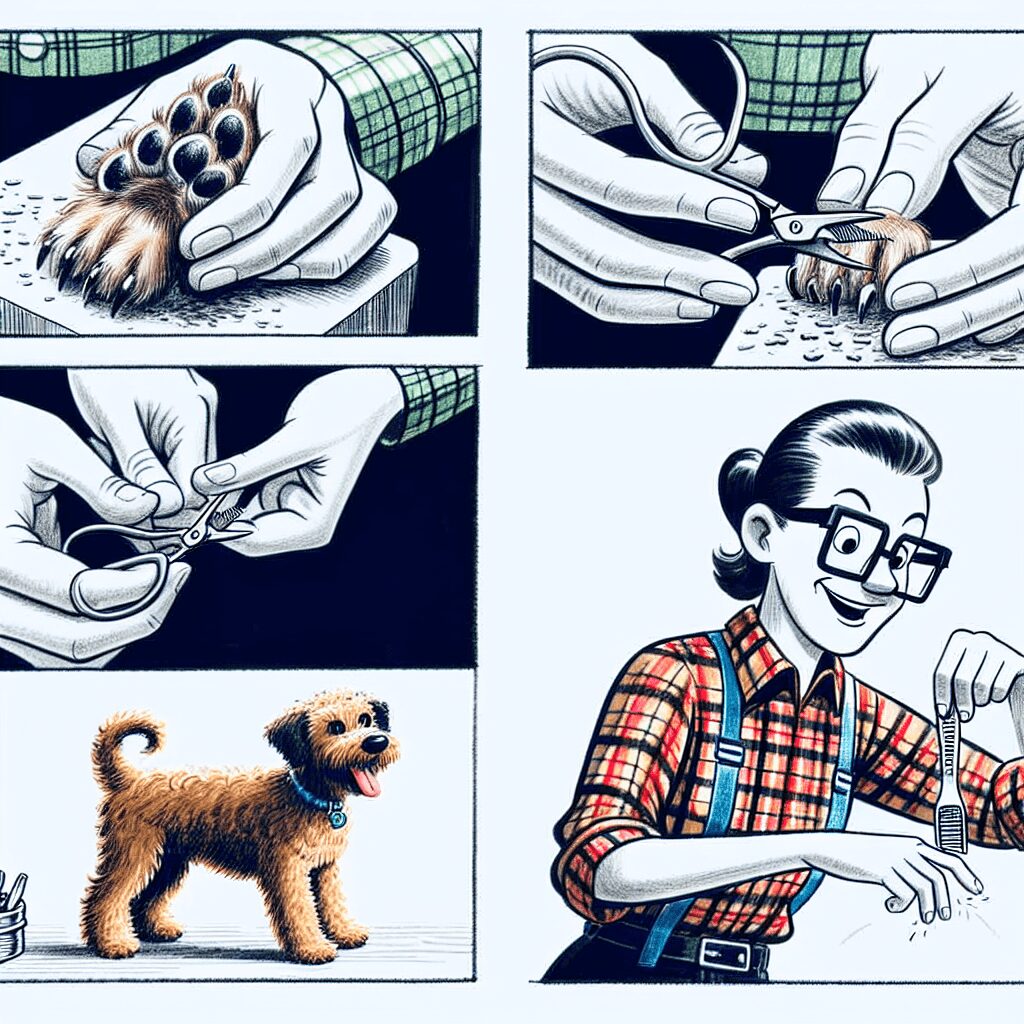Paw-sitive Grooming: A Step-by-Step Guide to Trimming Your Dog’s Nails at Home
Every dog lover knows that grooming is an essential part of keeping our furry friends healthy and happy. Among various grooming activities, trimming your dog’s nails is often the most daunting task. It’s vital for their well-being, yet many pet parents dread this process. But fear not! With the right approach, you can make nail trimming a stress-free experience for both you and your pup. In this blog post, we’ll explore everything you need to know about trimming your dog’s nails at home. Get ready for some paw-sitive vibes!
Chapter 1: Why Nail Trimming is Important
First things first, let’s talk about why nail trimming is essential. Keeping your dog’s nails at a healthy length is vital for various reasons:
-
Health: Long nails can lead to pain and discomfort, causing your dog to shift their weight awkwardly. This can result in joint pain and other issues over time.
-
Preventing Injury: Overgrown nails can break or get caught in objects, leading to injuries. It can also contribute to significant pain and bleeding.
-
Good Hygiene: Regular nail trimming helps maintain overall paw health. Dirt and bacteria can accumulate in long nails, leading to infections.
-
Comfort: Dogs with trimmed nails are generally more comfortable and can walk more naturally. It allows them to play and engage in their daily activities without discomfort.
-
Training and Socializing: A well-groomed dog is easier to manage in social settings and during training sessions.
Understanding the importance of nail trimming sets the foundation for why this task is crucial for your dog’s overall health and happiness.
Chapter 2: Gather Your Tools
Before you start, it’s essential to have the right tools at your disposal. Here’s what you need:
-
Dog Nail Clippers: There are different types available: guillotine-style, scissor-style, or electric grinders. Each has its advantages, so choose the one your dog seems most comfortable with.
-
Styptic Powder: This is crucial for stopping any bleeding that may occur if you accidentally cut too deep into the nail.
-
Dog Treats: Positive reinforcement is key when grooming. Having treats ready will help reward your pup for their cooperation.
-
A File or Grinder: This can help smooth out any rough edges after clipping to prevent snagging on carpets or furniture.
-
A Comfortable Setting: Find a quiet space where your dog feels safe. It could be in the living room, by your side, or outside on a sunny day.
Having the right tools and environment will set the stage for a successful grooming session.
Chapter 3: Assessing Your Dog’s Nails
Before diving in, take a moment to assess your dog’s nails. Here’s how:
-
Type of Nails: Observe whether your dog has light or dark nails. Light nails make it easier to see the quick (the pink part of the nail that contains blood vessels), while dark nails require caution as the quick is more challenging to identify.
-
Length Check: Look at the nail length. If your pup’s nails touch the ground when they walk, it’s time for a trim.
-
Condition: Examine for any signs of injury, cracks, or infections. If you notice anything concerning, consider a trip to the vet first before proceeding with trimming.
-
Comfort Level: Observe your dog’s reaction around their paws. Some dogs are more sensitive than others, and recognizing any anxiety signs early can help you create a more positive experience.
Understanding your dog’s nails and their comfort level will help you tailor your approach during the grooming session.
Chapter 4: Get Your Pup Comfortable
Here’s where the paw-sitive vibe comes into play! Creating a comfortable atmosphere is crucial. Follow these tips:
-
Familiarization: Start by gently touching and handling your dog’s paws on a regular basis, even outside of grooming sessions, so they get used to the feel.
-
Calm Environment: Ensure the space is free from loud noises and distractions. Turn on some soft music or have a second person hold your dog if they’re fidgety.
-
Positive Association: Have treats ready and encourage your dog with praise. If your dog appears anxious, spend a few minutes just petting them before beginning.
-
Short Sessions: If your dog struggles, consider breaking the job into short sessions where you trim a few nails at a time, rewarding them throughout.
-
Engage in Play: Sometimes a little play before grooming can help wear them out, making them more compliant during the session.
Having your dog comfortable and relaxed will set the tone for a successful and enjoyable nail-trimming experience.
Chapter 5: The Trimming Technique
Now that you’re all set up, it’s time to trim those nails! Here’s how to do it step-by-step:
-
Positioning: Hold your dog in your lap or have them sit beside you. Make sure you have control over the paw you’re trimming.
-
Identify the Quick: For light-colored nails, carefully identify the quick. For darker nails, trim gradually to avoid cutting too deep.
-
Trim with Caution: Use small, quick cuts. It’s better to trim a little and check than to cut too much at once. The goal is to avoid the quick while removing the excess nail.
-
Paw Handling: If your dog pulls away, gently hold their paw and reassure them with a calm voice. If they attempt to pull away, don’t force it; start with a few gentle clips before giving a treat.
-
Finish with a File: Once you’ve trimmed the nails, use a file or grinder to smooth out rough edges to prevent snagging.
This step-by-step approach will help you feel more confident during the trimming process while ensuring your dog’s safety.
Chapter 6: Handling Accidents and Stumbles
Sometimes, things don’t go as planned, and accidents may occur. Here’s how to handle it:
-
Quick Cuts: If you accidentally cut the quick and it starts to bleed, don’t panic! Apply styptic powder directly to the nail to help stop the bleeding. It’s a common mistake, especially with darker nails.
-
Stay Calm: Your dog can feel your energy. Stay calm and reassure them they’re okay. If they sense your anxiety, it may make them more skittish during future grooming sessions.
-
Take a Break: If the session becomes too stressful for either of you, take a break. It can be a few minutes, returning to an earlier chapter of comfortable handling and treats.
-
Learn and Adapt: Each grooming session is a learning experience. Take note of what worked and what didn’t, and adjust for next time.
By staying composed and prepared for minor setbacks, you’ll be better equipped to handle anything that comes your way.
Chapter 7: Maintenance and Routine
Once you’ve conquered the nail trimming session, think about establishing a routine!
-
Frequency: Depending on your dog’s activity level and nail growth rate, aim to trim nails every 3-6 weeks.
-
Establish a Routine: Try to make it a part of your regular grooming routine. Whether it’s after every bath or during a playdate, consistency will help your dog become accustomed to the process.
-
Potty Breaks: Plan nail trimming after a good play session or a potty break, ensuring your dog is calmer and more relaxed.
-
Support: If you find yourself hesitant, consider inviting a friend to help, or even consult a local pet groomer for tips on how to trim nails more effectively.
Creating a routine will allow you and your dog to anticipate nail trims, making it less daunting and more enjoyable.
Chapter 8: The Aftercare Experience
Now that the nail trimming is done, it’s time for the aftercare ritual!
-
Positive Reinforcement: Order a special treat or engage in a favorite game afterward. Make it a celebration! This reinforces that nail trimming is a good thing.
-
Check Paws: Always check your dog’s feet after the trim for any signs of irritation or injury from trimming.
-
Regular Grooming: Remember that maintaining your dog’s nails is just one part of their grooming routine. A bath, ear cleaning, and brushing are all essential for their overall health.
-
Monitor Reactions: Observe your dog’s behavior post-trim. If they seem uncomfortable or are limping, consult your veterinarian for advice.
-
Future Sessions: Keep track of your trimming schedule in a calendar or planner. Monitor how your dog responds so you can adapt and improve over time.
Aftercare is crucial not only for your dog’s health but also for reinforcing the positive connection between grooming and bonding!
Conclusion
Trimming your dog’s nails may seem daunting, but with patience, practice, and the right techniques, you can turn it into a rewarding experience for both you and your furry friend. Remember, regular nail trimming is an investment in your dog’s health and comfort. By establishing a comfortable routine and using positive reinforcement, not only will you keep those nails in check, but you’ll also strengthen that special bond you share with your pup! So, grab those clippers and treat your dog to a nail trim they deserve!
FAQs
1. How often should I trim my dog’s nails?
Most dogs need their nails trimmed every 3-6 weeks, but it depends on their activity level and natural wear.
2. What if my dog won’t let me trim their nails?
Start with gentle handling of their paws, reward them with treats, and gradually introduce the clippers. If they’re still resistant, consider professional grooming.
3. What if I accidentally cut the quick?
Don’t panic! Apply styptic powder to the nail to stop the bleeding. Comfort your dog and continue when they’re calm.
4. Can I use human nail clippers?
While it’s possible, it’s recommended to use dog-specific nail clippers for safety and comfort.
5. How can I tell where to cut?
For light nails, look for the pink quick. For dark nails, trim small amounts until you see a change in color, indicating you’re close to the quick.
6. What are the signs that my dog’s nails are too long?
If you can hear clicking on hard surfaces or if the nails touch the ground while standing, it’s time for a trim.
7. Is nail trimming painful for dogs?
When done correctly, it shouldn’t be painful. If your dog seems afraid or uncomfortable, ensure they’re relaxed and gradually ease into the process.
8. What are some tips for making nail trimming easier?
Try to create a calm environment, use treats as rewards, and trim regularly to make it a more familiar experience for your dog.
Unlock the Secrets to a Well-Behaved Dog! 🐾 Tired of your pup’s bad habits? Discover how to transform your unruly dog into a loving companion with our FREE Dog Training Mini Course! Learn essential commands, potty training tips, and effective techniques to eliminate unwanted behaviors in just days. Don’t miss out—sign up now and start your journey to a happier, obedient dog! Join Here! (https://bit.ly/3RJak0a)
Disclaimer: I may earn a commission from qualifying purchases as an affiliate. Please note that I only recommend products I believe will provide value to my readers.









